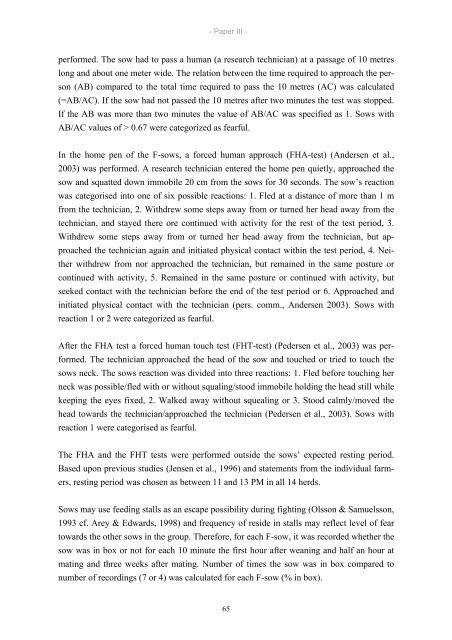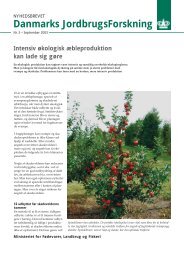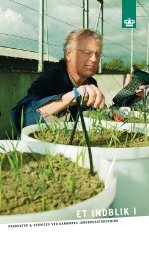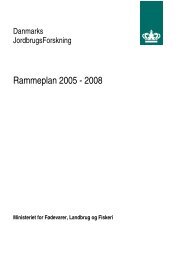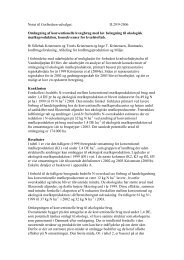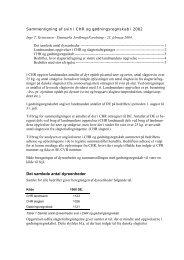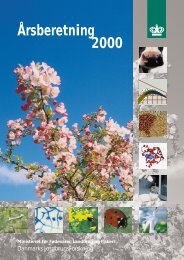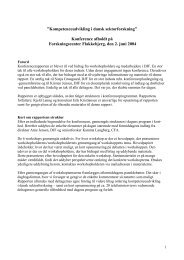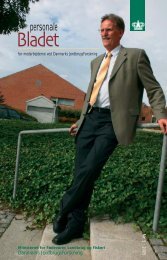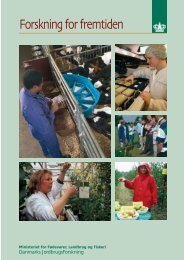Reproduction performances and conditions of group-housed non ...
Reproduction performances and conditions of group-housed non ...
Reproduction performances and conditions of group-housed non ...
You also want an ePaper? Increase the reach of your titles
YUMPU automatically turns print PDFs into web optimized ePapers that Google loves.
- Paper III -<br />
performed. The sow had to pass a human (a research technician) at a passage <strong>of</strong> 10 metres<br />
long <strong>and</strong> about one meter wide. The relation between the time required to approach the per-<br />
son (AB) compared to the total time required to pass the 10 metres (AC) was calculated<br />
(=AB/AC). If the sow had not passed the 10 metres after two minutes the test was stopped.<br />
If the AB was more than two minutes the value <strong>of</strong> AB/AC was specified as 1. Sows with<br />
AB/AC values <strong>of</strong> > 0.67 were categorized as fearful.<br />
In the home pen <strong>of</strong> the F-sows, a forced human approach (FHA-test) (Andersen et al.,<br />
2003) was performed. A research technician entered the home pen quietly, approached the<br />
sow <strong>and</strong> squatted down immobile 20 cm from the sows for 30 seconds. The sow’s reaction<br />
was categorised into one <strong>of</strong> six possible reactions: 1. Fled at a distance <strong>of</strong> more than 1 m<br />
from the technician, 2. Withdrew some steps away from or turned her head away from the<br />
technician, <strong>and</strong> stayed there ore continued with activity for the rest <strong>of</strong> the test period, 3.<br />
Withdrew some steps away from or turned her head away from the technician, but approached<br />
the technician again <strong>and</strong> initiated physical contact within the test period, 4. Neither<br />
withdrew from nor approached the technician, but remained in the same posture or<br />
continued with activity, 5. Remained in the same posture or continued with activity, but<br />
seeked contact with the technician before the end <strong>of</strong> the test period or 6. Approached <strong>and</strong><br />
initiated physical contact with the technician (pers. comm., Andersen 2003). Sows with<br />
reaction 1 or 2 were categorized as fearful.<br />
After the FHA test a forced human touch test (FHT-test) (Pedersen et al., 2003) was performed.<br />
The technician approached the head <strong>of</strong> the sow <strong>and</strong> touched or tried to touch the<br />
sows neck. The sows reaction was divided into three reactions: 1. Fled before touching her<br />
neck was possible/fled with or without squaling/stood immobile holding the head still while<br />
keeping the eyes fixed, 2. Walked away without squealing or 3. Stood calmly/moved the<br />
head towards the technician/approached the technician (Pedersen et al., 2003). Sows with<br />
reaction 1 were categorised as fearful.<br />
The FHA <strong>and</strong> the FHT tests were performed outside the sows’ expected resting period.<br />
Based upon previous studies (Jensen et al., 1996) <strong>and</strong> statements from the individual farmers,<br />
resting period was chosen as between 11 <strong>and</strong> 13 PM in all 14 herds.<br />
Sows may use feeding stalls as an escape possibility during fighting (Olsson & Samuelsson,<br />
1993 cf. Arey & Edwards, 1998) <strong>and</strong> frequency <strong>of</strong> reside in stalls may reflect level <strong>of</strong> fear<br />
towards the other sows in the <strong>group</strong>. Therefore, for each F-sow, it was recorded whether the<br />
sow was in box or not for each 10 minute the first hour after weaning <strong>and</strong> half an hour at<br />
mating <strong>and</strong> three weeks after mating. Number <strong>of</strong> times the sow was in box compared to<br />
number <strong>of</strong> recordings (7 or 4) was calculated for each F-sow (% in box).<br />
65


